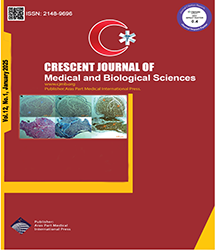
| Original Article | |
| Post-Hysterectomy Pelvic Presentations; Incidence and Clinical Significance | |
| Raziye Mohammad Jafari1, Mahin Najafian1, Zahra Kazemi1 | |
| 1Department of Obstetrics and Gynecology, Jundishapour University of Medical Science, Ahvaz, Iran | |
|
CJMB 2025; 12: 032-035 DOI: 10.34172/cjmb.2023.4004 Viewed : 3683 times Downloaded : 4830 times. Keywords : Hysterectomy, Pelvic, Hematoma, Pelvic fluid, Abnormal uterine bleeding, uterine prolapse, uterine fibroid |
|
| Full Text(PDF) | Related Articles | |
| Abstract | |
Objectives: This study aimed at evaluating ultra-sonographic manifestations in the pelvic system following hysterectomy surgery. Materials and Methods: This cross-sectional study examined women who underwent hysterectomy. The included women in the study underwent a pelvic ultrasound examination at three different time points. These three-time points were 3, 7, and 40 days after hysterectomy. All ultra-sonographic findings as well as women"s demographic data and clinical records were recorded in this study. Results: This study included a total of 80 women. The mean age of women was 53 years (between 36-72 years). The most common cause of hysterectomy in these women was abnormal uterine bleeding (AUB) with a frequency of 52.4%, followed by uterine prolapse and uterine fibroids with 16%. Ultrasound evaluation on the third day after surgery showed that 65 (81.2%) women had no pelvic symptoms, and 12 (16.25%) had free fluid. However, 7 women showed pelvic fluid accumulation from the seventh day, 3 of them showed hematoma, and 2 women showed a coincidence of hematoma and pelvic free fluid. In general, 9 women were hospitalized for fever complications. Conclusions: Overall, the findings of this study indicated that pelvic manifestations are a common hysterectomy-associated complication. Also, the study indicated that the pelvic manifestations usually resolve on their own and do not require therapeutic interventions. Moreover, this study did not find any relation between postoperative pelvic symptoms and febrile complications. |
Cite By, Google Scholar
Online Submission System
 CJMB ENDNOTE ® Style
CJMB ENDNOTE ® Style
 Tutorials
Tutorials
 Publication Charge
Medical and Biological Research Center
About Journal
Publication Charge
Medical and Biological Research Center
About Journal
Aras Part Medical International Press Editor-in-Chief
Arash Khaki
Deputy Editor
Zafer Akan


















